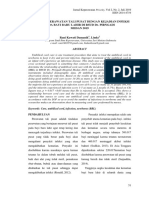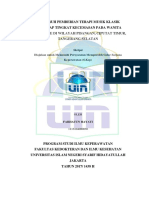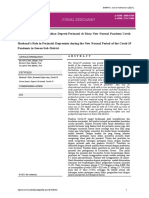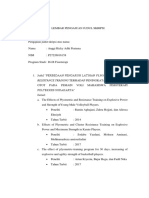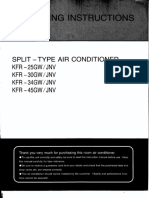0 ratings0% found this document useful (0 votes)
116 viewsMasalah Yang Sering Terjadi Pada Lansia
Masalah Yang Sering Terjadi Pada Lansia
Uploaded by
NadyaekafThis document summarizes various biological, psychological, social, and spiritual changes that can occur in the elderly. Biologically, the elderly may experience issues with their integumentary, neurological, cardiovascular, musculoskeletal, respiratory, gastrointestinal, genitourinary, and endocrine systems. Psychologically, they can experience depression, suicidal thoughts, perception issues, cognitive declines, and orientation problems. Socially, they may lose power, roles, prestige, commitments, and have impaired social contact. Spiritually, they seek truth, distance themselves from desires, and fulfill their religious obligations.
Copyright:
© All Rights Reserved
Available Formats
Download as PPTX, PDF, TXT or read online from Scribd
Masalah Yang Sering Terjadi Pada Lansia
Masalah Yang Sering Terjadi Pada Lansia
Uploaded by
Nadyaekaf0 ratings0% found this document useful (0 votes)
116 views13 pagesThis document summarizes various biological, psychological, social, and spiritual changes that can occur in the elderly. Biologically, the elderly may experience issues with their integumentary, neurological, cardiovascular, musculoskeletal, respiratory, gastrointestinal, genitourinary, and endocrine systems. Psychologically, they can experience depression, suicidal thoughts, perception issues, cognitive declines, and orientation problems. Socially, they may lose power, roles, prestige, commitments, and have impaired social contact. Spiritually, they seek truth, distance themselves from desires, and fulfill their religious obligations.
Original Description:
masalah lansia
Copyright
© © All Rights Reserved
Available Formats
PPTX, PDF, TXT or read online from Scribd
Share this document
Did you find this document useful?
Is this content inappropriate?
This document summarizes various biological, psychological, social, and spiritual changes that can occur in the elderly. Biologically, the elderly may experience issues with their integumentary, neurological, cardiovascular, musculoskeletal, respiratory, gastrointestinal, genitourinary, and endocrine systems. Psychologically, they can experience depression, suicidal thoughts, perception issues, cognitive declines, and orientation problems. Socially, they may lose power, roles, prestige, commitments, and have impaired social contact. Spiritually, they seek truth, distance themselves from desires, and fulfill their religious obligations.
Copyright:
© All Rights Reserved
Available Formats
Download as PPTX, PDF, TXT or read online from Scribd
Download as pptx, pdf, or txt
0 ratings0% found this document useful (0 votes)
116 views13 pagesMasalah Yang Sering Terjadi Pada Lansia
Masalah Yang Sering Terjadi Pada Lansia
Uploaded by
NadyaekafThis document summarizes various biological, psychological, social, and spiritual changes that can occur in the elderly. Biologically, the elderly may experience issues with their integumentary, neurological, cardiovascular, musculoskeletal, respiratory, gastrointestinal, genitourinary, and endocrine systems. Psychologically, they can experience depression, suicidal thoughts, perception issues, cognitive declines, and orientation problems. Socially, they may lose power, roles, prestige, commitments, and have impaired social contact. Spiritually, they seek truth, distance themselves from desires, and fulfill their religious obligations.
Copyright:
© All Rights Reserved
Available Formats
Download as PPTX, PDF, TXT or read online from Scribd
Download as pptx, pdf, or txt
You are on page 1of 13
Perubahan Pada Lansia
Biologis Psikologis Sosial Spiritual
Masalah pada Depresi, bunuh diri, Kehilangan Kebenaran
sistem integumen, Gangguan persepsi, kekuasaan, sejati,
neurologi, proses pikir, peran, Menjauhkan
cardiovasculer, Penurunan Penurunan hawa nafsu,
musculoskeletal, sensorium dan prestise, Melaksanakan
respiratori, kognisi, Berkurangnya amanah
gastrointestinal, Gangguan orientasi, komitmen, agama yang
genitourinary, Daya ingat Hambatan dianut
endocrine kontak sosial
1. Orthopnea, dyspnea, shortness of breath (respiratory
infection or disease)
2. Ruddy, pink coloring of face, trunk, limbs (COPD)
3. Bluish gray hue to face and neck (chronic, bronchitis)
4. Asymmetric lung expansion (acute pleurisy, pleural fibrosis,
pleural effusion, pain, fracture ribs)
5. Significant increase anteroposterior diameter that is greater
than lateral diameter (COPD)
6. Crepitus (crunchy feeling to skin resulting from air getting
trapped under epidermis)
7. Crackles, rales (extrainterstitial fluid due to CHF, pulmanary
edema, bronchitis, pneumonia)
8. Rhonchi, ratting (increased mucus production and partial
airway obstruction due to bronchitis, bronchiectasis)
9. Wheezes (presence of large amounts of thick mucus or
narrowing of airway due to asthma, pulmonary stenosis)
10. Pallor, confusion, fatigue, dyspnea (cardiac
desease)
11. Confusion, blackouts, fatigue, dizziness
(decreased carotic blood flow, aortic stenosis,
reduced cardiac output, digitalis toxicity)
12. Coughs, wheezes (left-sided heart failure)
13. Hemoptysis (pulmonary embolus, heart
failure)
14. Repeated BP > 160/95 (hypertension)
15. Arrhythmias (digitalis toxicity, hypokalemia,
infection, hemorrhage, cardiac disease)
1. Bleeding, irritation of esophagus (esophageal varicosities)
2. Exessive salivation, hiccups, dysphagia, anemia, thirst
3. Heartburn, dysphagia, belching, vomiting, regurgation, pain
4. Weight loss > 5% in last 30 days; > 10% in last 6 months
5. Pink or blue striae (recent stretching due to tumors, ascites,
obesity)
6. Jaundice (cirrhosis, gallstones, pancreatitis)
7. Rashes (irritation, drug reaction)
8. Small painless nodules (skin cancer)
9. Absent or reduce bowel sounds (late bowel obstruction,
peritonitis, electrolyte imbalances, handling of bowel during
surgery)
10. Increased bowel sounds (early bowel obstruction,
gastroenteritis, diarrhea)
11. Murmur over abdominal aorta (aneurysm)
12. Infrequent passage of stool, abdominal fullness and
discomfort, lethargy, poor appetite (constipation)
13. Diarrhea or seepage of stool, palpable mass in rectum (fecal
impaction)
14. Dark, tarry stools, (hemorrhoids, lower GI cancer,
diverticulitis)
15. Gray, tan, unpigmented stool (obstructive jaundice)
16. Pale, fatty stool (inflammation)
17. Small worms in stool or rectal area (pinworms)
1. Vaginal discharge, odor, irritation, soreness, itching (vaginitis,
moniliasis, trichomoniasis)
2. Protusion of vaginal wall outside vulva, pelvic pressure or
heaviness, urinary tract symptoms (prolapsed uterus, cystocele,
rectocele)
3. Palpable mass (cancer)
4. Dimpling and retraction of nipple; nontender, nonmovable hard
mass in breast (carcinoma)
5. Impotency (stress, depression, drug side-effects, fatigue,
overeating, neuropathy, long period of sexual inactivity)
6. Penile discharge (uretheritis, prostatitis, veneral disease)
7. Crooked, painful erection (peyronies disease)
8. Mass (carcinoma)
9. Scrotal pain, swelling (epididymitis, orchitis, carcinoma)
10. Prostatic enlargement (BPH)
11. Painful, edematous, reddened breast (irritation from suspenders,
restraint)
12. Incontinence (UTI, BPH, neurogenic bladder, tumor, cerebral cortex
lesion, calculi, medictions, altered cognition)
13. Increase urinary frequency (UTI, diuretic theraphy, increase fluid
intake, diabetes, hypocalcemia, anxiety)
14. Cloudy, alkaline, odorous urine; temperature elevation; frequency
(UTI)
15. Hematuria, pain, sign of UTI (renal calculi)
16. Painless hematuria, sign of UTI (bledder cancer)
17. Yellow-brown or green-brown urine (jaundice, obstructive bile duct)
18. Pink, red, or rust coloured urine (presence of bile, ingestion of
phenazopyridine)
1. Back pain (degenerative arthritis, muscle strain,
osteoporosis)
2. Joint pain, stiffnes,crepitus, bony
nodules/heberden node (osteoarthritis)
3. Joint pain, stiffnes, redness, warmth,
subcutaneous nodules over bony prominances,
atrophy of surrounding muscle, flexion
constractures (RA)
4. Calf cramps during exercise, relieved by rest
(intermitent claudication)
5. Red, dry, thickened piece of skin over bony
prominance ( corn)
6. Medical allocation of first metatarsophalangeal
joint (digiti flexus / hammer toel)
1. Dimentia : decrease in mental or
cognitive fuctional, following symtomp:
1. Aphasia (language disturbance)
2. Apraxia (impaired ability to perform
purposeful)
3. Agnosia (impaired ability to recognize
object or persons)
2. Dellirium is usually the result of stress,
drug intoxication, sensory overload or
deprivation, or medical condition
Alzheimer’s Disease
1. Cognitive deficits, including memory impairment
2. One or more of the following symptoms:
1. Language disturbance
2. Impairment in ability to perform motor activities
3. Inability to name objects
4. Problem with planning, organizing, or thinking abstrac
3. Significant decline in former level of functioning,
including social or occupational
4. Gradual onset and progressive cognitive decline
5. Cognitive deficits are unrelated to other physical or
mental condition
Sundown syndrome: increase in
behavior problems such: wondering,
agitation, and disorientation after the sun
goes down.
You might also like
- Parts Manual: Daimlerchrysler Om 442Document67 pagesParts Manual: Daimlerchrysler Om 442Bassie100% (4)
- CASE 580N-Backhoe-Service-Manual-diagram-electricDocument1 pageCASE 580N-Backhoe-Service-Manual-diagram-electricWuillians GuzmanNo ratings yet
- Sample Birthing Plan 1: Bullet Format: Mother-To-Be: Birth SiteDocument4 pagesSample Birthing Plan 1: Bullet Format: Mother-To-Be: Birth SiteKwenaNo ratings yet
- Baby SpaDocument2 pagesBaby SpakeyNo ratings yet
- Experiment 3 Pulsed Column Liquid-Liquid Extraction ColumnDocument13 pagesExperiment 3 Pulsed Column Liquid-Liquid Extraction ColumnFikri IlyasNo ratings yet
- Jurnal KORELASI ANTARA STATUS GIZI IBU MENYUSUI DENGAN KECUKUPAN ASIDocument9 pagesJurnal KORELASI ANTARA STATUS GIZI IBU MENYUSUI DENGAN KECUKUPAN ASIMarsaidNo ratings yet
- Post Partum Blues PenelitianDocument14 pagesPost Partum Blues PenelitianSundariNo ratings yet
- Lampiran 6. LEMBAR OBSERVASI SKALA NYERIDocument1 pageLampiran 6. LEMBAR OBSERVASI SKALA NYERIannisafnNo ratings yet
- The Cost of CareDocument3 pagesThe Cost of CareSpeech & Language Therapy in PracticeNo ratings yet
- Konsep Normal Pada PersalinanDocument25 pagesKonsep Normal Pada PersalinanFitri RitongaNo ratings yet
- Group 2: Patient Admission & Present Perfect TenseDocument52 pagesGroup 2: Patient Admission & Present Perfect TenseDwi Dian NitamiNo ratings yet
- Dis. IK. 20-19 Wij D DAFTAR PUSTAKADocument6 pagesDis. IK. 20-19 Wij D DAFTAR PUSTAKADahayu Science GlobalNo ratings yet
- Perbandingan Pemberian Ikan Gabus Dan Telur Ayam Terhadap Penyembuhan Luka Pasca Bedah Post Sectio CeasereaDocument11 pagesPerbandingan Pemberian Ikan Gabus Dan Telur Ayam Terhadap Penyembuhan Luka Pasca Bedah Post Sectio CeasereaSaskiyanto ManggabaraniNo ratings yet
- MANUSKRIPDocument11 pagesMANUSKRIPandika saputraNo ratings yet
- Manajemen Nyeri Post PartumDocument14 pagesManajemen Nyeri Post PartumIlfa Tiara Milsa100% (1)
- Leaflet Senam HamilDocument2 pagesLeaflet Senam HamildianawatiNo ratings yet
- Perilaku Wanita Menopouse Di Wilayah Kerja Puskesmas Kolaka Kabupaten Kolaka TAHUN 2012Document123 pagesPerilaku Wanita Menopouse Di Wilayah Kerja Puskesmas Kolaka Kabupaten Kolaka TAHUN 2012Arisa CaNo ratings yet
- Pengaruh Pemberian Pendidikan Kesehatan Mobilisasi Dini Dengan Lama Hari Rawat Pada Pasien Post Operasi Sectio CaesariaDocument7 pagesPengaruh Pemberian Pendidikan Kesehatan Mobilisasi Dini Dengan Lama Hari Rawat Pada Pasien Post Operasi Sectio CaesariaAditya PradithaNo ratings yet
- Ebook EkonomiKesehatan OrganizedDocument52 pagesEbook EkonomiKesehatan Organizedpaulospam0No ratings yet
- Perawatan BBLDocument12 pagesPerawatan BBLmelatiNo ratings yet
- Hubungan Pengetahuan Tentang Tanda Bahaya Kehamilan Dan Dukungan Keluarga Dengan Kepatuhan Kunjungan Antenatal Care ANCDocument9 pagesHubungan Pengetahuan Tentang Tanda Bahaya Kehamilan Dan Dukungan Keluarga Dengan Kepatuhan Kunjungan Antenatal Care ANCNur Maulida AkmaliahNo ratings yet
- Pengaruh Pemberian Aromaterapi Jahe Terh 2Document7 pagesPengaruh Pemberian Aromaterapi Jahe Terh 2Lastri Khairin100% (1)
- Pengaruh Effleurage Massage Terhadap Nyeri Persali (1) - DikonversiDocument14 pagesPengaruh Effleurage Massage Terhadap Nyeri Persali (1) - DikonversiMihnati NatiNo ratings yet
- Jurnal Massage PunggungDocument14 pagesJurnal Massage PunggungPrisma TikaNo ratings yet
- Askep Preeklampsia - CoverDocument6 pagesAskep Preeklampsia - CoverARNo ratings yet
- 92 Personal HygieneDocument9 pages92 Personal HygieneanisNo ratings yet
- Hubungan Popok Instan Terhadap Kejadian RuamDocument6 pagesHubungan Popok Instan Terhadap Kejadian Ruamnida fadilahNo ratings yet
- Jurnal Birth BallDocument6 pagesJurnal Birth BallElis SumiatiNo ratings yet
- Skripsi Tablet FeDocument7 pagesSkripsi Tablet FeYessiana Luthfia BahriNo ratings yet
- Tren Dan Isu Dalam Keperawatan KeluargaDocument16 pagesTren Dan Isu Dalam Keperawatan KeluargaHarun Al RasyidNo ratings yet
- Jurnal Komprehensif Pada NeonatusDocument14 pagesJurnal Komprehensif Pada Neonatusdesy sekarini100% (1)
- Buah Naga MerahDocument7 pagesBuah Naga MerahAnitaDh'yanaNo ratings yet
- Jurnal Hubungan-Perawatan-Tali-Pusat-Dengan-Kej-3e562ac0Document10 pagesJurnal Hubungan-Perawatan-Tali-Pusat-Dengan-Kej-3e562ac0Edwar RusdiantoNo ratings yet
- Adaptasi Masa NifasDocument28 pagesAdaptasi Masa NifasEliza HafniNo ratings yet
- Farhatun Hayati FkikDocument123 pagesFarhatun Hayati FkikMatt Kurniawan SevenfoldismNo ratings yet
- Skripsi Word PDFDocument91 pagesSkripsi Word PDFOpi RahmaNo ratings yet
- Wafda Jurnal+bahasa+inggrisDocument9 pagesWafda Jurnal+bahasa+inggrisDesta Ayu Cahya RosyidaNo ratings yet
- Penurunan Kecemasan Ibu NifasDocument6 pagesPenurunan Kecemasan Ibu NifasTimmy LarasatiNo ratings yet
- Literature Review: Pengaruh Pendidikan Kesehatan Menggunakan Media Audiovisual Tentang Menarche Terhadap Kesiapan Siswi SD Menghadapi MenarcheDocument10 pagesLiterature Review: Pengaruh Pendidikan Kesehatan Menggunakan Media Audiovisual Tentang Menarche Terhadap Kesiapan Siswi SD Menghadapi Menarcheangghi oktavianiNo ratings yet
- Hubungan Karakteristik Ibu Inpartu Terhadap Kejadian Perdarahan Postpartum Di Rsu Budi Kemuliaan Periode Tahun 2019Document10 pagesHubungan Karakteristik Ibu Inpartu Terhadap Kejadian Perdarahan Postpartum Di Rsu Budi Kemuliaan Periode Tahun 2019MiMa Muach LadyzNo ratings yet
- Histologi Organ EndokrinDocument32 pagesHistologi Organ EndokrinJasselia FeiNo ratings yet
- Anemia Dalam Kehamilan-OliviaDocument20 pagesAnemia Dalam Kehamilan-OliviaSwitha Martha Sinaga100% (1)
- Tujuan Pembelajaran: Asking - Filling in Medical ReportDocument8 pagesTujuan Pembelajaran: Asking - Filling in Medical ReportNesi AgustiaNo ratings yet
- Bukti LoA Jurnal Ilmiah PDFDocument1 pageBukti LoA Jurnal Ilmiah PDFAgung SetiabudiNo ratings yet
- Rangkuman Undang-UndangDocument59 pagesRangkuman Undang-UndangDidi HaryadiNo ratings yet
- Soap-Midwifery Study ProgramDocument5 pagesSoap-Midwifery Study ProgramWahyu Kusuma DewiNo ratings yet
- Pengaruh Deep Back Massage Terhadap Penurunan NyeriDocument14 pagesPengaruh Deep Back Massage Terhadap Penurunan NyeriMaharRkpNo ratings yet
- Pathway SCDocument2 pagesPathway SCRizky TiaraNo ratings yet
- Baby BluesDocument30 pagesBaby BluesStefanie KarinaNo ratings yet
- Tugas Review Jurnal Maternitas IiDocument10 pagesTugas Review Jurnal Maternitas IiMahasiswa PEBRIANINo ratings yet
- Kelompok 7 Perinial CareDocument3 pagesKelompok 7 Perinial CareNursyifa SofiantiNo ratings yet
- Pengaruh Terapi Birth Ball Terhadap Intensitas 2020Document5 pagesPengaruh Terapi Birth Ball Terhadap Intensitas 2020salsabila.asyifaNo ratings yet
- Askeb KBDocument14 pagesAskeb KBRianaNurFatimahNo ratings yet
- Efektivitas Pemberian Rebusan Jahe Dan Daun MintDocument10 pagesEfektivitas Pemberian Rebusan Jahe Dan Daun MintRiana Pasca Roshian100% (1)
- Laporan Pendahuluan: Untuk Memenuhi Tugas Individu Praktek Profesi Keperawatan Stase Keperawatan AnakDocument9 pagesLaporan Pendahuluan: Untuk Memenuhi Tugas Individu Praktek Profesi Keperawatan Stase Keperawatan AnakMelina Defita SariNo ratings yet
- Efek Aroma Terapi Lavender Untuk Mengurangi Nyeri Masa Nifas PadaDocument6 pagesEfek Aroma Terapi Lavender Untuk Mengurangi Nyeri Masa Nifas Padaartha margarethaNo ratings yet
- Skripsi Maryati Juni 2Document116 pagesSkripsi Maryati Juni 2intan kusumaNo ratings yet
- LEAFLET MenopauseDocument2 pagesLEAFLET MenopauseNailah RahmahNo ratings yet
- Lembar Pengajuan Judul SkripsiDocument4 pagesLembar Pengajuan Judul SkripsiAnggi Rizky Adhi PratamaNo ratings yet
- Makalah RW SiagaDocument11 pagesMakalah RW SiagaUli Rahma Dini SNo ratings yet
- Peran Bidan Daam Promkes MentalDocument141 pagesPeran Bidan Daam Promkes MentalluxNo ratings yet
- Asuhan Kebidanan Ibu Hamil Patologi, Andra DewiDocument13 pagesAsuhan Kebidanan Ibu Hamil Patologi, Andra DewiSilva RachmaNo ratings yet
- 1) Side Effects of LasixDocument7 pages1) Side Effects of Lasixالغزال الذهبيNo ratings yet
- 0613 CT 0001Document180 pages0613 CT 0001Anas BasarahNo ratings yet
- Fonko Staro Upatstvo PDFDocument27 pagesFonko Staro Upatstvo PDFJebi SeNo ratings yet
- SVCC 101Document28 pagesSVCC 101Marck JunoNo ratings yet
- AmrutaVahini - February-2023 - Aham Brahma Sarvam Brahma - DR Nithya SakshiDocument50 pagesAmrutaVahini - February-2023 - Aham Brahma Sarvam Brahma - DR Nithya SakshiHiramalini SeshadriNo ratings yet
- MCQ Unit 5Document4 pagesMCQ Unit 5zohaibNo ratings yet
- The Printmaster GTO 52 Offers You Ideal Solutions in A3 Format For Discerning CustomersDocument1 pageThe Printmaster GTO 52 Offers You Ideal Solutions in A3 Format For Discerning CustomersLucas ViniciusNo ratings yet
- Operator's Manual DI16 EMS - PDE Eng Issue 2083248Document59 pagesOperator's Manual DI16 EMS - PDE Eng Issue 2083248gennaroNo ratings yet
- Battery Chemistry ECDocument38 pagesBattery Chemistry ECharikaa1905No ratings yet
- Cancer OPED DR Mugambi - Final ShortenedDocument2 pagesCancer OPED DR Mugambi - Final ShortenedCosmas MugambiNo ratings yet
- Low-Power Rs-485 Line Driver and Receiver Pairs: FeaturesDocument24 pagesLow-Power Rs-485 Line Driver and Receiver Pairs: FeaturesSandroCezardeAraujoNo ratings yet
- The Hydraulic Machinery of Obervermuntwerk IIDocument8 pagesThe Hydraulic Machinery of Obervermuntwerk IIPeter MeusburgerNo ratings yet
- Management For OsteosarcomaDocument2 pagesManagement For OsteosarcomakyawNo ratings yet
- Portland Cement Concrete Pavement (0.230m THK., 3500 Psi)Document1 pagePortland Cement Concrete Pavement (0.230m THK., 3500 Psi)anthony christian yangNo ratings yet
- Open Caisson: Underwater Construction Technique and PlacementDocument9 pagesOpen Caisson: Underwater Construction Technique and PlacementVishwas.S. P YadavNo ratings yet
- Methanol SynthesisDocument6 pagesMethanol SynthesisGaurav BurdeNo ratings yet
- TOLENTINO VJS. EXPT-4-power-in-ac-circuitsDocument8 pagesTOLENTINO VJS. EXPT-4-power-in-ac-circuitsVj TolentinoNo ratings yet
- Life in The Llanos of Venezuela.Document548 pagesLife in The Llanos of Venezuela.sagallaneraNo ratings yet
- MG Drug StudyDocument3 pagesMG Drug StudySandra MedinaNo ratings yet
- Etiqa Home Secure - Agency - 1.2 - 2023Document30 pagesEtiqa Home Secure - Agency - 1.2 - 2023Prinsip Mutiara M Sdn BhdNo ratings yet
- Applied Business Statistics, 7 Ed. by Ken BlackDocument31 pagesApplied Business Statistics, 7 Ed. by Ken BlackShruti DawarNo ratings yet
- Electrical System PC 1250-11RDocument31 pagesElectrical System PC 1250-11Rgire_3pich2005No ratings yet
- Part-1 of 3 Basic On Process SimulationDocument13 pagesPart-1 of 3 Basic On Process SimulationErwinApriandiNo ratings yet
- HK2 FP7 1Document3 pagesHK2 FP7 1trieuNo ratings yet
- 3 - FractionsDocument6 pages3 - FractionsNikhil PatelNo ratings yet
- Crowd System MaintenanceDocument8 pagesCrowd System MaintenanceVentasVarias AntofaNo ratings yet
- Annotated Bibliography of Research On Marijuana and HealthDocument7 pagesAnnotated Bibliography of Research On Marijuana and HealthqueenstartoNo ratings yet
- Exercise: Stack 2: Csc248 Fundamental of Data StructuresDocument4 pagesExercise: Stack 2: Csc248 Fundamental of Data StructuresZahiraNo ratings yet
































